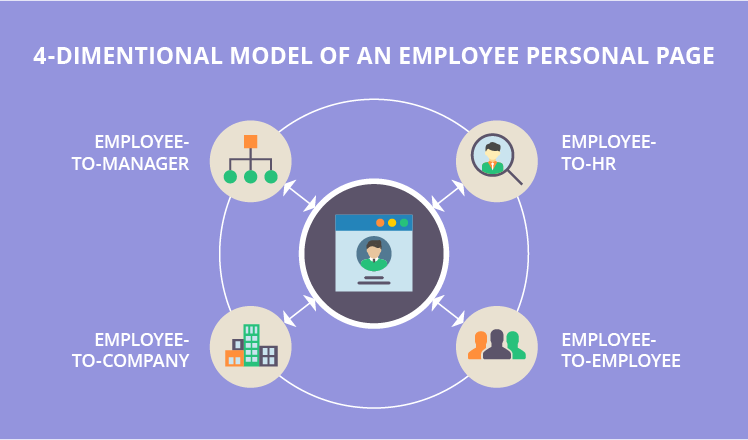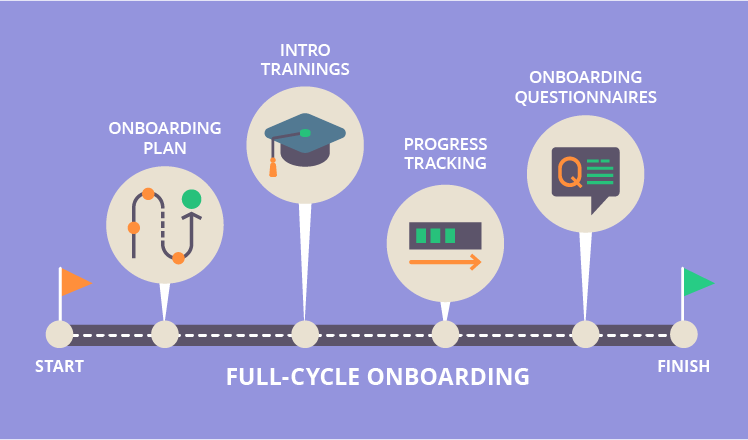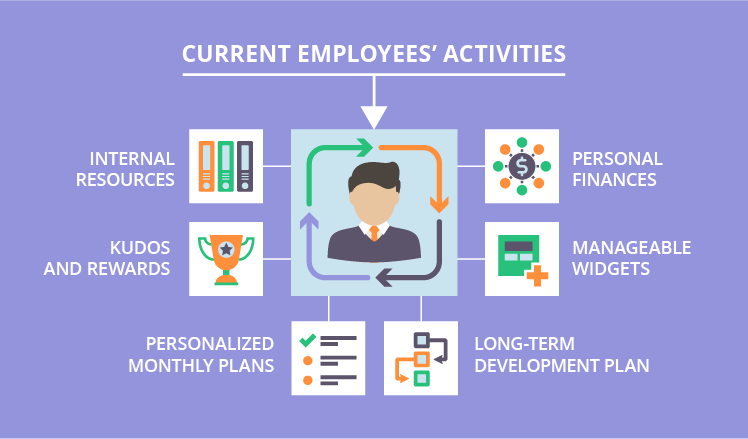Employee personal pages: How to make them the core of successful HR management
Nowadays, it’s impossible to surprise anyone with intranets widely adopted by companies of all sizes. However, organizations usually focus on delivering a one-size-fits-all functionality, yet somehow such an integral part of any intranet as personal pages of employees gets frequently overlooked. Although they are supposed to be a link between companies and their staff, personal pages are rarely used to their full potential and traditionally contain only employees’ contacts, job titles, short bios and hardly anything else, often looking empty and boring.
We at ScienceSoft strongly believe that an employee personal page has much bigger potential than being a simple business card. Moreover, it can become a vital tool improving not only employee engagement but also leveraging staff retention. You can see an example of an efficient employee personal page in our interactive demo.
4 dimensions of an employee personal page
The problem of underdeveloped personal pages, actually, has a very logical ground: companies just won’t spend their money on personal pages with no clear benefits for the organization on the whole. For personal pages not to be just an optional appendage of an intranet, they should be transformed into a valuable tool facilitating human resource management on a company level, stimulate engagement on a personal level, as well as intensify interaction between a company and an employee.
All these incarnations of a personal page can be put together into a 4-dimensional model:

Dimension 1: Employee-to-manager
A personal page is the touchpoint of employees and their line managers, facilitating task distribution and progress assessment, enabling timely consultations on problematic issues and relevant corrections in both current working plans and employees’ long-run development strategy.
Dimension 2: Employee-to-HR
A personal page is also the central node of employees’ interaction with HR managers. On the one hand, an employee can use a personal page to communicate with an HR department, which is extremely important, say, during the onboarding period or at any critical moments during an employee’s career. On the other hand, a personal page should become the main source of personal information that can be used by HR managers on a daily basis to track working time and PTO, or on-demand to follow employees’ personal development, assign new professional levels, get their feedback and more.
Dimension 3: Employee-to-company
A personal page will aggregate personalized corporate information (e.g. available training, professional contests and events) as well as provide access to internal corporate resources, such as document storages, knowledge bases or wikis, task management systems, etc. A personal page can also be used by an employee to accumulate important corporate information related to company-wide offerings, such as insurance programs, available discounts and other.
Dimension 4: Employee-to-employee
A personal page should become the primary point for employees to reach out corporate collaboration sites, find information about their peers, follow each other’s interests and activities, join working groups, share professional experience, discuss business issues and more.
Developing must-have features
To become really personal, employees’ pages should provide relevant working tools, be easily manageable and scalable. These requirements find their way into customizable solutions with wide collaboration capabilities, such as SharePoint.
Whether a company chooses to develop personal pages on SharePoint or decides to go with another collaboration platform, there is a set of important features to implement, in order to transform a personal page into a first-aid working kit assisting employees in their daily working activities.
Enabling full-cycle onboarding management
One of the most important roles of a personal page is to facilitate onboarding and allow employees to join a new team quicker and easier. At this stage, all 4 dimensions should work at fullest to provide employees with the following tools:

Onboarding plan. According to the stats provided by UrbanBound, US & UK companies spend nearly $37 billion to keep unproductive employees who don’t understand their jobs. Not to get into these stats too, a company should complete a comprehensive introduction of employees to their responsibilities during the adaptation period. For this purpose, a newcomer’s personal page should contain a detailed onboarding plan with precise to-dos and goals to achieve during first working months.
Intro training. A personal page should provide a newcomer with direct access to all introduction materials, training videos and guides essential to understand the scope of work. All materials are to be tailored to a job profile (marketing managers and accountants will obviously have absolutely different information to learn) and well-structured to prevent information overload.
Progress tracking. It’s also important to provide visibility into newcomers’ activities to an HR manager and a line manager. This way, they can follow the dynamics of employees’ working processes, assess their onboarding progress, apply corrective actions on the go if required and give feedback.
Onboarding questionnaires. A personal page can be a part of a company’s ‘continuous listening’ strategy. This strategy implies gathering feedback and taking actions at all stages of the employee lifecycle and usually starts with analyzing the onboarding process during newcomers’ first days with the help of relevant questionnaires on the employee engagement, socialization and satisfaction level.
Supporting current employees’ activities
Once the onboarding period is over, a personal page will provide tools necessary to manage current employees’ day-to-day activities.

Direct access to internal resources
A personal page should include useful links to essential corporate software and information resources such as enterprise systems, knowledge base, organizational chart, corporate policies, etc. However, links are to be delivered smartly: there should be no more than 10 stand-alone links placed on a page. If the links are numerous, it’s recommended to group them into logical sub-groups to avoid a mess. Moreover, personal pages cannot do without personalized, job-related links, so that accountants or business analysts can access the resources they use most.
Well-structured, personalized monthly plans
First of all, with personal pages in place, line managers will be able to deliver a personalized monthly working plan for each employee to clearly understand their current and short-term goals. A plan can be coupled with task management tools to control personal timetable and deadlines. Without replacing dedicated task management software, this plan will help managers a lot in following the general flow of employees’ activities and achievements. Moreover, this feature can be extremely beneficial for smaller companies that can’t invest in complex task management systems.
Long-term motivating development plan
An employee can be provided with a long-term development plan with major objectives for at least a year. The plan can include several intermediate goals or milestones that employees should reach to advance in their career or get a new professional level. This plan will be a great motivator for every employee who now could see precise targets. The plan should also be visible for HR and line managers to follow the development of the staff and to find candidates for promotion among already existing employees quicker instead of searching for new specialists outside the organizations.
Kudos and rewards
This feature can be implemented as a stand-alone widget displaying employees’ achievements, recent awards or important projects accomplished. This will be purely a motivating tool to let employees see their victories, small and big, and feel inspired. A system of virtual rewards can be introduced along with relevant corporate gifts (a branded bag, a certificate, etc.).
Personal finances
No, there is no need to implement the Internet banking functionality on personal pages. However, employees will be able to see their salary statements, check bonuses and access their financial balance sheets.
Manageable widgets
Personal pages can be hardly considered as such if there are no tools to personalize them. So it’s reasonable to provide employees not only with standard customization of page color schemes or wallpapers, but also foresee a set of manageable widgets to tailor the page to an employee’s working needs. For example, sales managers may need a calculator or a to-do list to mark out important meetings during the day. A project manager working across different regions will be happy to see various time zone clocks, as well as a mini project planner to follow the project progress.
Companies that opt for SharePoint intranets have significant advantages since almost all of the above-mentioned features can be found in the platform’s out-of-the-box capabilities. Furthermore, SharePoint developers can assist in creating a set of custom add-ins that will offer various features to meet the requirements of specialists from different departments.
Pages for employees, benefits for the entire company
Developing deeply personalized employees’ pages isn’t an easy task since it requires hard work and intensive collaboration of HR managers, line managers and software developers to pick appropriate tools that will do for every employee. At the same time, adopting personal pages gives solid advantages to all the parties.
For newcomers, a personal page is the door to faster assimilation and a better understanding of job responsibilities. For current employees, this is the chance to have a personal working space for solving daily tasks quicker and more efficiently. For HR managers, personal pages will reflect employees’ advance in their professional development, as well as serve as an essential tool for stimulating employee engagement. For line managers, this is the tool to save valuable time and make staff management more efficient. And finally, for companies on the whole, investing in personal pages means to build up reliable and strong relations with their employees, thus ensuring their commitment and retention in the long haul.

